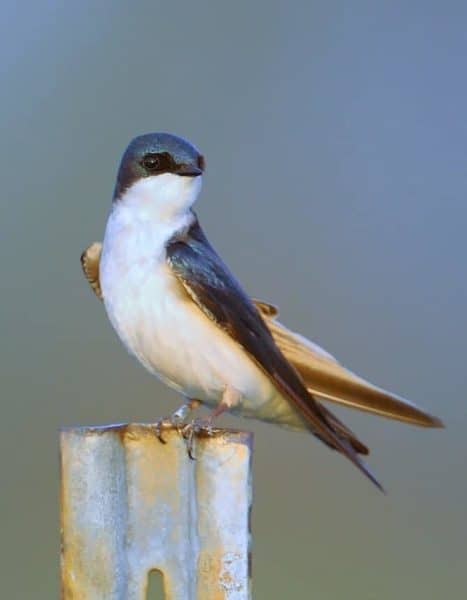A sharp decline in migratory bird populations has flummoxed ecologists trying to pinpoint the risks faced by these birds. New Cornell research points to a possible explanation for declines: the connection between aquatic insect prey and bird reproductive performance.
Cornell ecologists found that aquatic insects, which are much richer in highly unsaturated omega-3 fatty acids (HUFAs) compared with terrestrial insects, strongly influence the fledging success of tree swallows. The research, published Nov. 12 in the journal Ecology Letters, points to the role played by food quality – and the conservation of natural habitats critical to aquatic insect populations – in the preservation of wild bird species.
Tree swallows, like many other migratory songbirds that rely on a diet of flying insects, have been hit by severe population declines in recent decades.
“We’ve been studying tree swallows and their food for over 30 years, and the importance of HUFAs has really taken us by surprise,” said David Winkler, professor of ecology and evolutionary biology in the College of Agriculture and Life Sciences.
HUFAs, which are important nutrients during development for humans as well as wild birds, are abundant in aquatic insects and algae but are scarce in terrestrial insects as well as in most plants and seeds. Using data obtained over 24 years of regular insect sampling at the Cornell Experimental Ponds, the researchers found that variation in aquatic insect biomass while parents were feeding chicks had a very strong effect on the fledging success of the birds.
This was most strongly felt one week after hatching, when chicks undergo rapid growth as the parents hunt nearby prey and bring meals to their young. The strong effect of HUFA-rich aquatic prey suggests that chicks are gaining the key nutrient that terrestrial prey lack, according to Cornelia Twining, Ph.D. ’18.
“This work validates what we’ve found about the importance of HUFAs for tree swallows and other aquatic insect-eating birds in previous experimental studies, and shows that seemingly subtle nutritional differences can have real impacts on bird breeding success in nature, Twining said.
Aquatic insects like Nematocera (aquatic midges) are most abundant in late spring, which coincides with peak tree swallow hatch dates. But breeding early brings risks for birds: The researchers found that cold spells could kill upward of 86 percent of chicks in a single day. Winkler credited co-author J. Ryan Shipley, Ph.D. ’18, for an extensive analysis of the long-term data, which allowed Winkler to observe that “despite the risks of early breeding, access to aquatic insects and the HUFAs they contain may provide a key evolutionary advantage to breeding early.”
“This is a wonderful example of what it takes to get the most out of long-term ecological studies: stubborn devotion to collecting the data coupled with ground-breaking research by brilliant young scientists and their insightful analyses of long-term data,” said Winkler.


